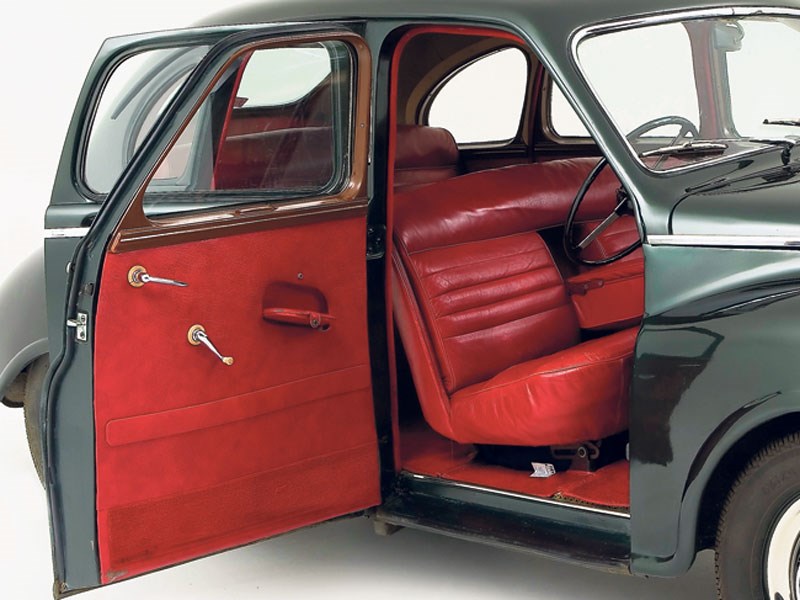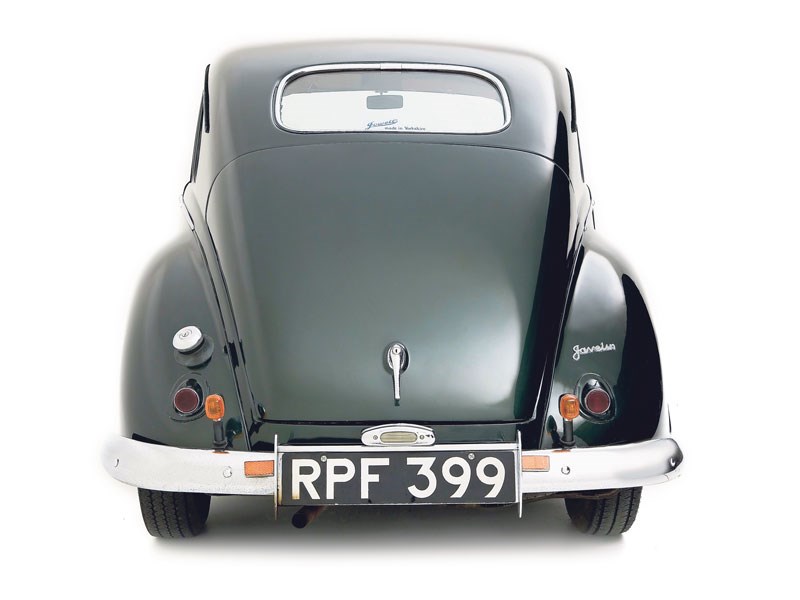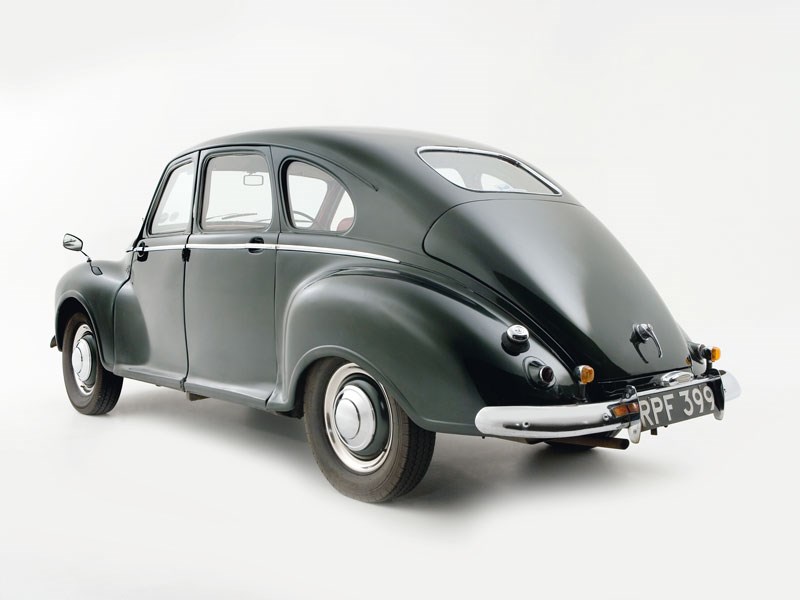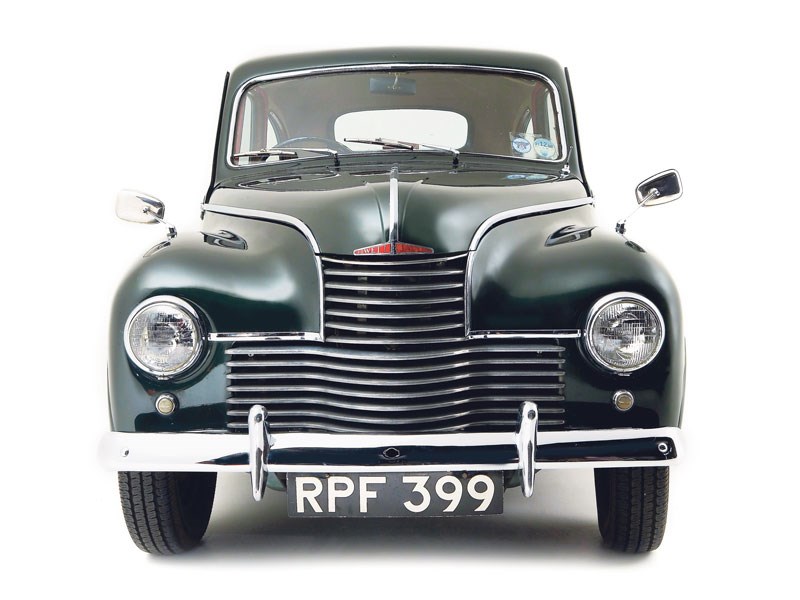The Javelin – built from 1947 to 1953 – is an ideal candidate if you’re looking for an elegant classic that stands out from the crowd.
Open the rear-hinged door, slide onto the bench seat, and you’re faced with a large metal-spoked steering wheel and simple dash. And simplicity is a watchword for the lovely Javelin – there’s nothing complicated in the cabin and all the controls fall easily to hand, which means you can just enjoy the driving experience. It really is enjoyable, too: the flat-four thrums away steadily, the gearlever snicks easily into place, and ample performance is on tap. The Javelin rides and handles tidily thanks to a long wheelbase and torsion bar springing, while accurate steering and easily-modulated brakes make this a delightful car to punt down your favourite B-roads. Space may be quite tight for larger drivers, but at least your passengers will be comfortable, and if you’re looking for an interesting daily driver that’s more than capable of tackling lengthy excursions this fine saloon could be the perfect classic for you. Buy now before the market wakes up to its charms.
VITAL STATISTICS
Jowett Javelin
Engine 1486cc/4-cyl/OHV
Power (bhp@rpm) 50bhp@4500rpm
Torque (lb ft@rpm) 77lb ft@2600rpm
Top speed 78mph
0-60mph 22.2sec
Consumption 32mpg
WHAT TO LOOK FOR
BODYWORK & CHASSIS
Not surprisingly for a car of this age, rust can be a major problem, so examine the steel bodywork carefully. Areas particularly at risk include the leading and trailing edges of the front and rear wings, around the headlamps, the sills, the door bottoms (caused by blocked drain holes) and the boot floor. Also check the door pillars thoroughly. Any bubbling needs further investigation, but the good news is that many panels are available from the owners’ club. Exterior trim is available too, but check it’s complete and in good condition – particularly the grille, which has a hinged top half giving access to the fluid filler pipes.
Take a good look underneath – although built from good quality steel, the separate chassis is susceptible to corrosion. Check the outriggers, jacking points and chassis extensions beneath the boot, and pay particular attention to the mounting points for the front and rear torsion bars and the rear axle link arms. Cracks can also form around the mounting points for the front torsion bars and around the bracket at the rear of the steering box – the latter is very hard to spot unless the car is on a ramp. Lift the base of the rear seat and check the suspension mountings and floor – repairs here are tricky and can incur hefty labour costs. The club can supply repair sections, so it’s not a major problem as long as the rot hasn’t spread too far.
ENGINE
The flat-four engine was innovative for 1947 and early cars suffered broken crankshafts and blown cylinder head gaskets, though these should have been sorted out many years ago. The motor is buried deep inside the engine bay, so checking for oil leaks is tricky but worth doing. The top-mounted radiator makes checking the cooling system easy; it needs the correct concentration of antifreeze to avoid crankcase corrosion, so ensure it’s not plain water. Check for excessive oil smoke from the exhaust, caused by splits or failed seals in a metal vacuum pipe that balances the carburettors – it passes through the crankcase and oil can be drawn in and burnt. Overall reliability should be good as long as the car has been well maintained, so quiz the owner about the maintenance regime. If the engine has been rebuilt ensure it was done by a reputable specialist – assembly calls for experience, and poorly fitted cylinder liners will cause a host of problems.
ELECTRICS
The top-model 300SE and 300SEL had air suspension, which was high-tech stuff for the early 1960s. The ride it gives is quite remarkable, but problems can be very expensive indeed to fix, and parts are not plentiful. Buy an air-sprung Fintail with your eyes wide open, and have the phone numbers of a specialist and your bank manager close at hand.
RUNNING GEAR
Problems afflicted the Jowett-made four-speed manual gearbox that replaced the Meadows ’box of early Javelins, but any problems should have been sorted out by now. The column change should be slick in operation – investigate further if it’s not, though all parts are available if it needs to be reconditioned. Also listen out on your test drive for clunks from worn propshaft joints. The Salisbury rear axle is considered bulletproof.
BRAKES
Early models had hydraulic front brakes and mechanically operated rears, with hydraulics all-round from 1950. Neither set-up is prone to problems as long it’s been maintained properly, and an overhaul is an inexpensive DIY job. The steering rarely gives problems, so it’s just a case of checking for excessive play during the test drive; the same applies to the suspension. A host of greasing points need regular attention, so examine them for evidence of recent lubrication. Worn joints and bushes are likely to be the extent of any issues (rust in spring mounts aside). The club can supply everything you need for an overhaul, so don’t worry if things feel a little tired.
INTERIOR
Interior trim and fittings in need of renovation are easy to spot. De Luxe models came with a wooden dash and leather seats – bear in mind the cost if they need extensive refurbishment. This needn’t be a deal-breaker, though, as parts aren’t as rare as you might fear. Chromed parts can also be difficult to come by, so ensure that they are all present and correct. Tarnished chrome can be repaired with relative ease, but heavily pitted and damaged components may be beyond repair.
OUR VERDICT
The Javelin was an interesting and innovative car when it was new, and more than 60 years later it’s a fascinating slice of British motoring history. Solid construction and reliable running gear make it a tempting choice for newcomers and experienced classic owners alike. The owners’ club has worked hard to secure an impressive parts supply, with plenty of components being re-manufactured, so keeping one on the road is relatively straightforward.




